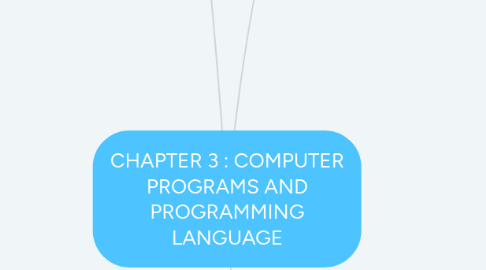
1. PROGRAMMING LANGUAGE PARADIGMS
1.1. PROGRAMMING PARADIGMS
1.1.1. A model for a class of programming language that share a common characteristics and its differences
1.1.2. COMMON PROGRAMMING PARADIGMS
1.1.2.1. IMPERATIVE PARADIGM
1.1.2.1.1. Describe how the computer should achieve solution
1.1.2.1.2. Examples of language
1.1.2.1.3. Key Features
1.1.2.2. OBJECT-ORIENTED PARADIGM
1.1.2.2.1. Based on imperative/procedural style with added data & code abstraction & encapsulation
1.1.2.2.2. A revolutionary concept that changed the rules in computer program development
1.1.2.2.3. OOP is organized around object rather actions, data rather than logic
1.1.2.2.4. Examples of language :
1.1.2.2.5. Key Features:
1.1.2.3. THE FUNCTIONAL PARADIGM
1.1.2.3.1. Based on the concept of functionsin mathematics
1.1.2.3.2. Based on Lambda calculus
1.1.2.3.3. Programs written are compact, but run slowly and require a lot of memory
1.1.2.3.4. Examples of language :
1.1.2.3.5. Key Features :
1.1.2.4. THE LOGIC PARADIGM
1.1.2.4.1. A declarative and relational style of programming
1.1.2.4.2. Concept is based on {Horn Clauses}
1.1.2.4.3. Based on facts and rules known as {Clauses}
1.1.2.4.4. Clauses may contain {logic variables} which take any value necessary to make the fact or the left side of the rules match a goal
1.1.2.4.5. Key Features :
2. PROGRAMMING APPLICATION DOMAINS
2.1. PROGRAMMING LANGUAGE
2.1.1. C
2.1.2. COBOL
2.1.3. Fortran
2.1.4. C++
2.1.5. Perl
2.1.6. Java
2.1.7. ML
2.1.8. Lisp
2.1.9. Simula
2.2. WEB SOFTWARE
2.2.1. Ecletic collection of language:
2.2.1.1. MARKUP ( HTML)
2.2.1.1.1. Used for annotating a document in manner that can be distinguished from the text
2.2.1.2. SCRIPTING (PHP)
2.2.1.2.1. The language that enable the script to run these commands and typically include control structures such as if-then-else and while-do
2.2.1.3. GENERAL PURPOSE (JAVA)
2.2.1.3.1. Can be used for a wide range of programming jobs
3. OVERVIEW OF COMPUTER PROGRAM AND
3.1. COMPUTER PROGRAM
3.1.1. Set of instructions that the computer needs to follow to process the data into information
3.1.2. ELEMENTS OF COMPUTER PROGRAM
3.1.2.1. INPUT :- Whatever data that is inserted into a computer using input devices
3.1.2.2. PROCESSING :- Convert input data into information
3.1.2.2.1. STORAGE :- Store the data or information for future use (permanently or temporarily)
3.1.2.2.2. OUTPUT :- Generate the useful information using output devuces
3.1.2.2.3. STORAGE :- Store the data or information for future use (permanently or temporarily)
3.1.2.3. INPUT :- Whatever data that is inserted into a computer using
3.1.3. LANGUAGE
3.1.3.1. PROGRAMMING LANGUAGE
3.1.3.1.1. System of signs used to communicate a task/algorithm to a computer, causing the task to be performed
3.1.3.1.2. Contains set of instructions, data and rules that are used to construct a program
3.1.3.1.3. 3 levels of programming languages:

